
It’s no secret I love Cadillacs. Even more so when the Cadillac is “triple yellow”, meaning paint, top and interior are all in that classic Cadillac pastel yellow. In 1977 it was Naples Yellow, in 1978 it was slightly paler and renamed Colonial Yellow.
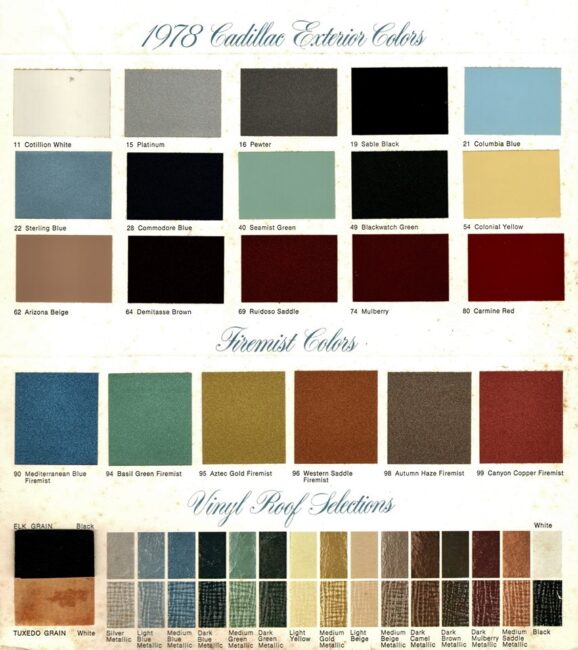
After a brief disappearance in 1981 (the color that year, Waxberry, was closer to an off-white than strictly yellow) it returned for 1982 and in 1983 was renamed Cameo Ivory. Other than a brief spastic renaming for 1986-’87.
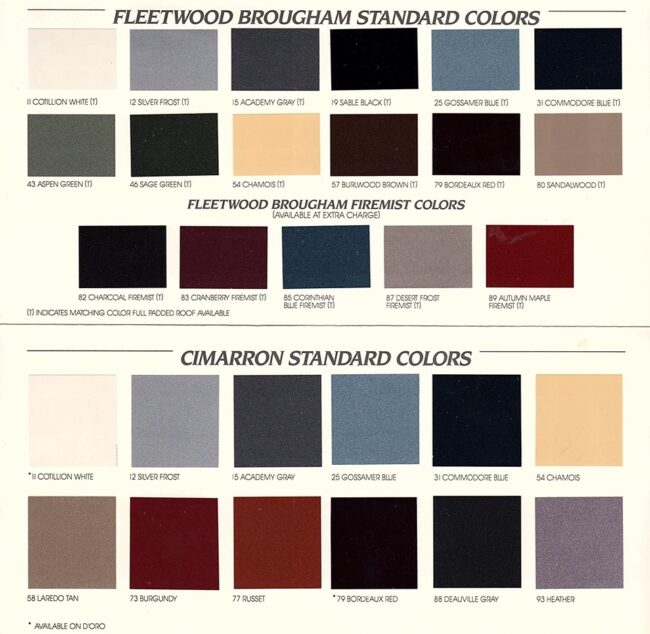
1986 Cadillac colors
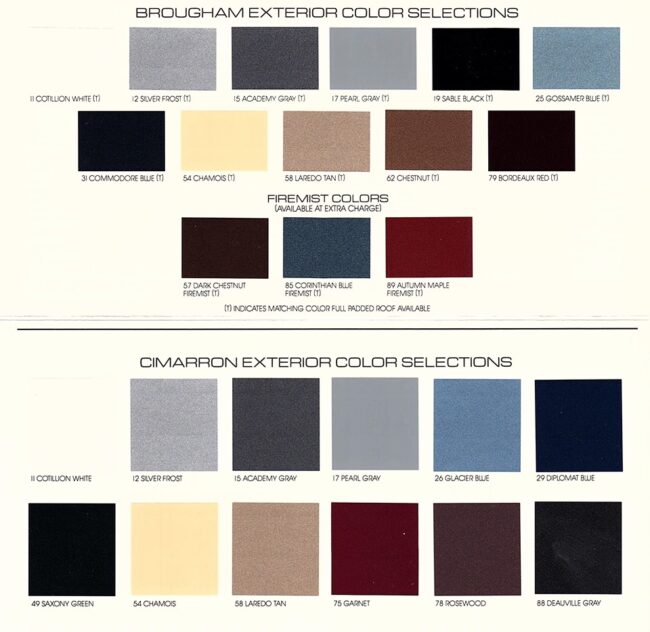
1987 Cadillac colors
To Sunburst Yellow on Eldorado/Seville ’86-’87, Almond on de Ville/FWD Fleetwood in ’86, Sunburst Yellow on de Ville/FWD Fleetwood in ’87, and Chamois on the RWD Brougham and Cimarron in ’87-’88. Confused yet? Cameo Ivory returned in ’88 and remained an available color all the way through 1991.
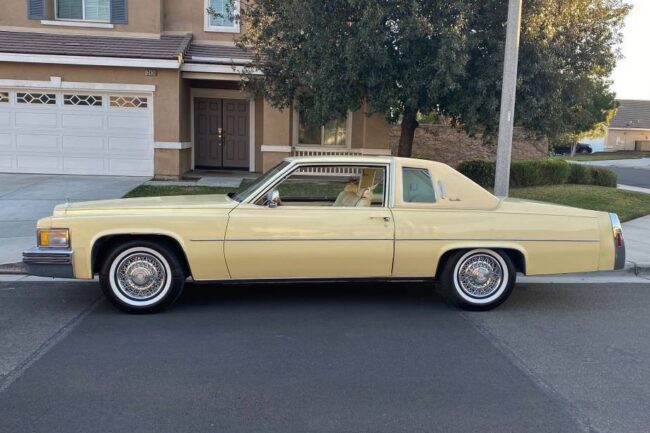
I always liked it. Likely because in 1986 my parents special ordered a new 240DL wagon from Lundahl Volvo. My mom picked Cream Yellow with a tobacco brown interior, and the color, if not the exact same color as Cadillac’s, was very, very close. My dad liked it so much he had his ’51 Porsche 356 Cabriolet, being restored at the time, painted that color too.
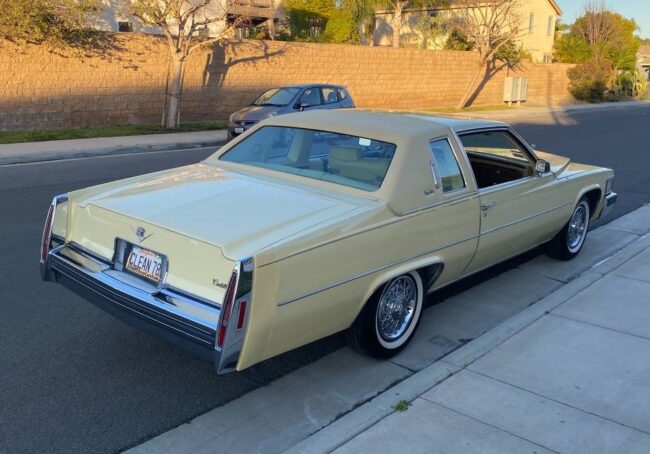
As to our featured car, I spotted it this very afternoon on Finding Future Classic Cars on FB. It looks to be a very nice, if not perfect, example. Sad about the cracked dash, but that’s a pretty common malady on most all 1970s American cars.
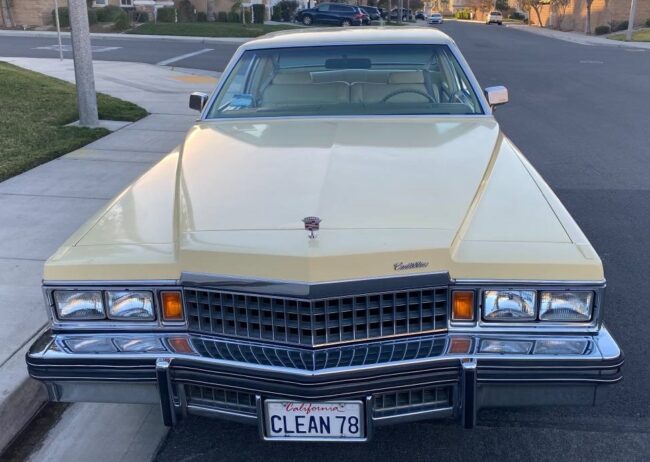
Per the ad (the car was on San Diego CL as of this writing): “1978 Cadillac Coupe Deville, one owner grandpa‘s car, garage kept, all original.”
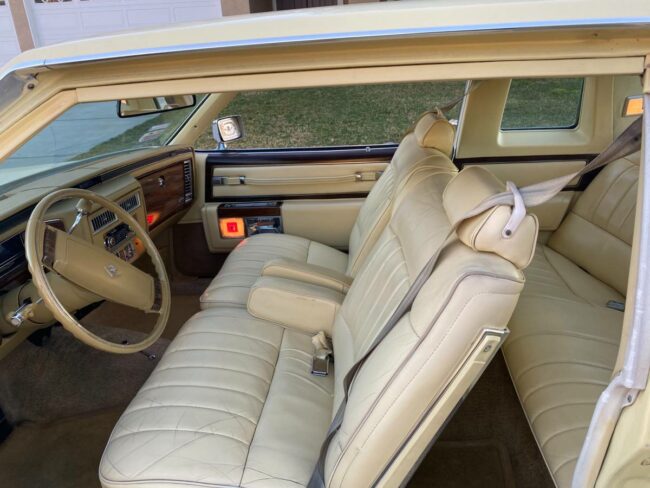
“63,000 original miles runs and drives amazing. No problems, original paint. Very rare to find three-way yellow (ED: not really, this was a fairly popular combo when new, the ’77 brochure even showed one in these colors), new tires, new brakes all original no accidents.
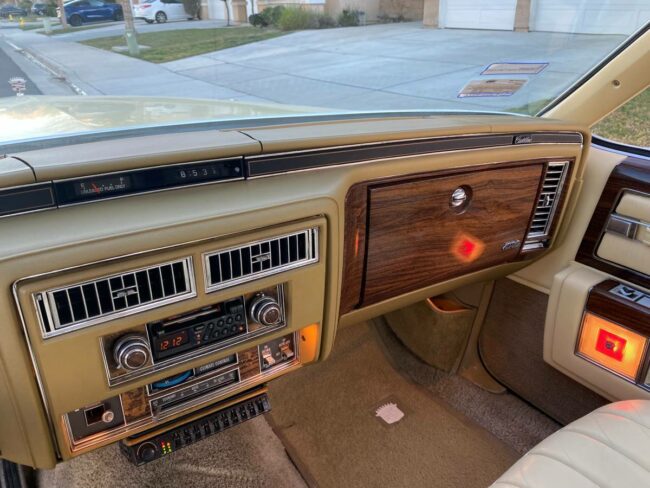
“Registered up-to-date daily driver great classic lotta fun to drive show is a head turner will not last too long asking for $16,500.”
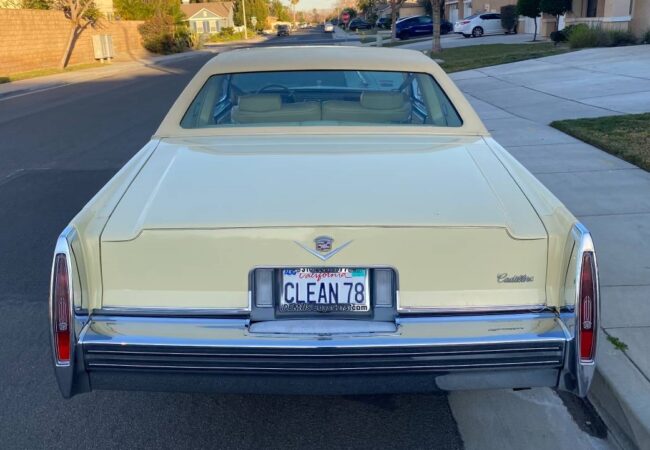
The gigantic run-on sentence that was in the ad was painful to read (I edited it with punctuation, my OCD required it). These were nice driving cars, with the 425 CID and THM automatic. And since they were smaller than the 1971-76 gunboats, they’re relatively practical to drive.
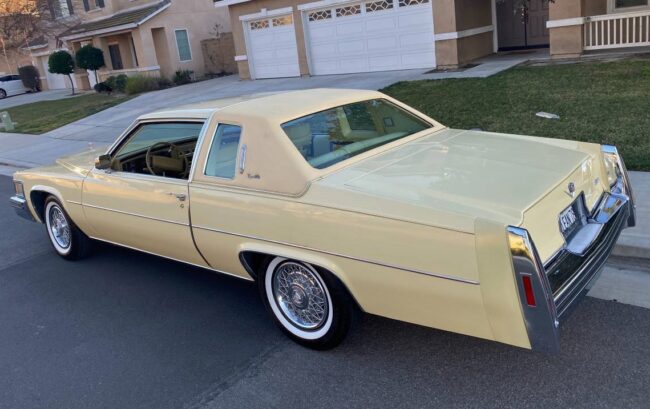
And unlike that ’77 Caprice I posted, this one has all the power options, is the more desirable coupe, and, at least in your author’s opinion, a desirable color combination. Is it worth 16,500? Well, the fillers appear to have been replaced, as there aren’t any cracks/chunks missing out of them. So they won’t be falling apart, but it would have been nice if they could have matched it to the paint.
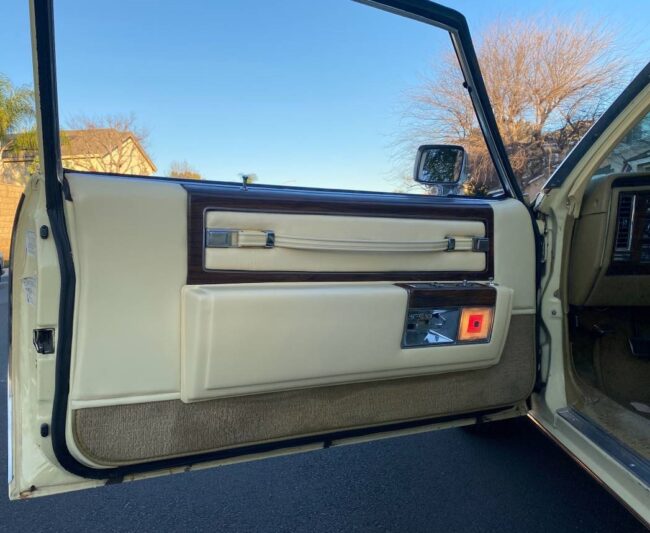
CA car likely means no or little rust-but that’s not for certain. It’s probably the high side value wise, I’d think more like 9000-9500 tops with that cracked dash and poorly painted fillers. Still an attractive survivor though! My friend Jayson, who’s more conversant on ’70s Cadillac values, had this to say: “Yeah, I agree, not 16.5. They didn’t even finish the pin stripe on the new fillers. That would have helped to conceal the mismatched shades. More of a 10 to 11K maybe.”
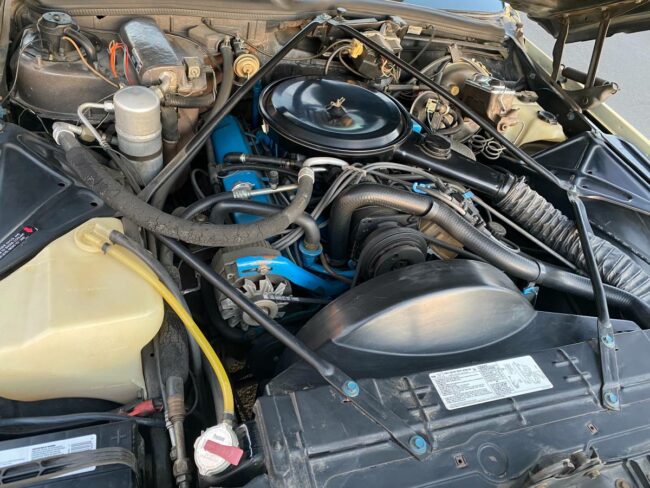







74 Comments
Now that is a car! The days when the Cadillac name meant something. Spacious, elegant, classy, and imposing.
People can have their Mercedes or BMWs. You could fit one of those in the trunk.
Nice. I do miss colors. They went away in the late ‘80s and have never really returned. My ‘69 Dart GTS 340 was close to this shade of yellow. It wasn’t until the 1970 model year that Mopar went wild with colors like Sub Lime and Plum Crazy. I forget what the bright yellow was called.
Lemon Twist on Plymouths, Top Banana on Dodges.
Here is a good article on how the Chrysler High Impact colors came to be. There are other good postings about car colors at this site. I do not like the silver/gray world of today.
https://autouniversum.wordpress.com/2021/03/09/jock-fearer-and-the-birth-of-chryslers-high-impact-color-program/
A drive by your local Dodge dealer will show plenty of color. The Charger/Challenger have lots to choose from. I think the Mustangs and Broncos have a pretty good selection too.
True enough about Dodge but the local Ford dealer has nothing but white F-150s (and not many of them) dotting its huge lot.
They’ll sell you an orange mustang, but you’ve gotta custom order it and get it some time in the next 3-5 business years. I’d own one if I could even kinda justify the money.
“3-5 business years.” Hahaha!
Patrick, it is the new business model for the new car dealer principles, limit inventory and therefore the invenstment in floorplanning, put additional dealer mark up on the MSRP on the existing inventory even on the showroom paperweights, charge new car prices for the preowned trade ins, make your customers face 3 hours of saying “no” to additional warrenties and service, and make the buying experience so dreadful that your customers never come back but make enought money on the deal that it does not matter… Like Jack has pointed out, dealer principles can just put the dealership on auto pilot and print money….
With inflation running at over 15% according to the inflation indicators used in the early 80s when we last had high inflation, interest rates are going to make the car business interesting. Dealer floor plan loans at 10+% interest, and consumer car loans at 15+% will certainly change a lot of perspectives on inventory and purchase choices.
Tom, I agree with Jason, not a $16.5k car but nice example. I $10k tops would be a buy. Eric in PA who like Jason is an expert on tri-sevens agrees (Eric has two Black w/red leather interior 5k mile cars a 78 and 79) This example is a highly optioned CDV and it was nice that they used the original radio knobs on the after market radio. Those cracks on the upper dash to the left of the gas guage and to the right of the clock were very common on the tri-sevens especially California, Arizona, Texas cars. Unforturnately that upper dash is a pain to replace due to getting everthing to line up and you are dealing with 40+ year old plastic and clips. I would say the mileage is correct due to the lack of ware on the driver side door panel and seat. You are correct the rear quarter extension replacements adds value. With cracked or missing extensions this would be a $6k car due to how bad it looks when they are missing or falling apart. Looks like they took good care of this car or had it detailed and the AC was converted to 134.
Glad that 16K is high. I’d love a cheaper, cosmetically worse, example to put a big block chevy in. I’ve got a bike I don’t need a fast car. All I need the caddy to do is make a lot of noise driving my buddies and I to the bar and make women think I’ve got a 2″ dong.
Lynn, if you mean Eric De Virgilis, I know him. 🙂
Tom, he is the one, the CLC expert on tri-sevens 🙂 🙂
What is the cost to correctly replace the plastic fillers?
CitationMan, First, it is not so much the cost as the quality of the replacement parts. NOS Rear Quarter Extension have not been available from the dealers for several decades. There is one or two companies that make reproductions but the quality is questionalble. The originals were made out of urathene (sp), the replacements are made out of hard plastic. Where the originals ones were soft the replacements are hard plastic or in some cases fiberglass. Therefore the fit and finish that the body shop starts with is not as good as originals. Next, GM was still using lacquare paint when these cars were made which hardly any body shop uses today. So matching with two stage paint is an issue as show in the car for sale here. No matter how hard you try it is not a perfect match. Lastly, price the replacement extensions run about $500. Labor for installation is market dependent but generally about $1,500 to $2,000. Hope this helps.
Thanks, I remember these yellowing on my Dad’s ‘80s white Sedan de Ville.
For this price, I think I would rather have the orange Eldorado from Spokane. Then again, I paid $3.469 for gas today, and I’m sure it will go up another 10% before the next time I fill up.
Did you end up getting the last of the V8 Tundras?
Just saw this. Nice colors, Astroroof. Only thing I’d change is swap the wire wheel covers for Buick Road Wheels. https://nmi.craigslist.org/cto/d/rogers-city-1978-buick-park-avenue/7438985881.html
Tom, that Park Avenue coupe would be a great supper club cruiser…. The way the advertisement is written it could have been an GM employee factory ordered car. They could buy at invoice and they tended to load up the car with options, like the very highly priced Astro Roof. 😉
Were I picking a Coupe de Ville in 1978, and that does sound fun. I would pick night watch green or mulberry if I was feeling conformist. Preferably with the color keyed wheels and the FI. I know the FI could cause trouble but actual well off people are not going to own it much out of warranty, and will have a relationship with the dealer. The triple yellow calls to mind an ad from the time with a younger big afro black women in pants and the car having a 70s pool chair multicolor polyester upholstery. One of the things I love about such cars is that they were actually designed by men like me for men like me, so no sale.
One big mystery when looking at this car is why GM took so long to develop a 4 or 5 speed overdrive automatic. Imagine if the 1980 refresh that cleaned up the aerodynamics a bit and offered some weight savings had also included standard multi-port FI on the 425 and a 5 speed OD automatic. I would bet serious money that such combination would have gotten better MPG on the EPA and real world driving tests than the anemic 368, 8/6/4, and HT 4100 crap that they “invested in” instead. After all, 100% of their full-size cars and probably 90% of their other vehicles and trucks used 3 speed automatics, the fuel crisis hit in 1973 and CAFE in 1975, how hard was it to see that making an OD automatic would be the easiest way to hit fuel economy targets without gutting performance? Answer: the GM beancounters found it would cost an extra $5 bucks per unit and decided it was more profitable to just chop cubic inches – brand equity and customer satisfaction be damned.
The problem with building cars for the EPA test cycle with the technologies that existed was that they got worse mileage rather than better. Car and Driver’s test of the 425 de Ville in 1978 resulted in 16.0 urban and 17.5 miles per gallon highway. No version of either version of the gutless 368 ever used fuel as parsimoniously, and I rather doubt that the HT4100 ever produced those numbers in Car and Driver’s hands either. Meanwhile, the seven-liter V8 made for a Coupe de Ville that was quicker and more efficient than a Mercedes-Benz 280E.
https://www.flickr.com/photos/cadillacben/7861095884/in/album-72157631245896734/
Basically the reason modern turbo motors get such high fuel economy is because they have 8-10 speed automatics and enough low end torque to keep the motors well below 2,000 RPM in most normal usage conditions. The same is true with modern Corvettes, Mustang V-8s, and pickups that keep their big motors running slow most of the time with lots of gears, which is why 400+ HP can still hit 25-30 mpg on the highway. Putting some anemic 368 or 267 or 231 V-8/V-6 in front of an OD automatic didn’t work very well because those motors didn’t have enough low RPM torque to pull a cruising gear on a big heavy car, which is why there were constant complaints about gear-hunting when GM and Ford finally go around to putting in OD automatics. I imagine a 425 Caddy with FI and a 5 speed automatic and a few aero tweeks could easily have done low/mid 20s on the highway back in the day and mid-teens in the city cycle while giving Caddy buyers the reliable power and quick acceleration they wanted and expected.
There was a fuel-injected 425, but it was so bad that Cadillac gave CandD a carbureted one to test instead. Five speed automatics weren’t viable in 1978, and Detroit unleashed various four-speed automatics before they were really ready too.
Fuel injection could be made to work very well in the late 70s, Volvo, BMW, MB, and even VW were using it on almost everything with mostly good results (certainly better than carbs). The original Hydramatic automatic from 1939 was a 4 speed unit, and Allison division of GM was making 5+ speed automatics for trucks starting in the 1950s, so I expect a 4-5 speed automotive unit could have been done in the late 70s by the largest car company in the world. I think the problem with the first 4 speed OD automatics in the early 80s was that they were basically trying to graft on an extra gear to the 3 speed rather than clean-sheet designs, plus they were hooked up to such anemic engines they could pull the over-drive gear except going downhill, with the added bonus of dismal quality control and rampant cost cutting.
There’s more to it than the number of speeds. Three-speed planetary automatics with torque converters were better performers than any of the earlier four-speed fluid-coupling automatics. Work trucks have different design priorities than Cadillacs. The proof that the biggest car company couldn’t have pulled off five-speed automatics for luxury cars in the late ’70s is that they couldn’t pull off four-speed automatics that were appropriate for luxury cars in the late ’70s. As for fuel injection, they don’t seem to have been willing to license the existing Bendix/Bosch systems that were sorted out, and what they did instead wasn’t very good. Lately, I’ve been seeing GM fanatics defending TBI. It wasn’t going to produce a 50% increase in fuel economy and power.
Adding gears to the transmission is usually done to disguise a lack of torque. If you look at CJ’s C/D page, the direct drive third is decently tall. The overdrive and shorter drive ratio came in with the 4.1 and were not a sign of strength, but rather a work around for only loosing another few hundred pounds in the next round of austerity. Makes you see why they thought they had to go FWD.
I have seen CJ’s C/D article before. You may have enjoyed it as the hippy editors spend much time making fun of the kind of people that buy Cadillacs. They can do this secure in the knowledge of never any pushback or turning the much needed mirror onto them. Notice they went further into fake news in not testing with the hotter engine. Remember the short lived editorial position was that the austerity was good, so having an Impala 350 seem the fastest of the downsizes makes the unspoken point that there is no reason anymore for a big block V8. Hippys trying to destroy.
Funny to imagine Car and Driver of the seventies as “Hippys trying to destroy.” That’s not my memory, as a subscriber from 1968 to the present. But then again, I was a hippy myself at the time and probably blind to that characterization.
I DO remember Brock “The Assassin” Yates and David E. Davis, Jr. and their iconoclasm and humor but if Charles Fox’s review of the 1968 Corvette with electrical issues and rain pouring through the ill-fitting T-Top was fake news they sure pulled the wool over my eyes.
They definitely influenced this long-hair to switch allegiances from my Dart GTS to a ’71 BMW, based largely on DED’s “Turn Your Hymnals to 2002” piece, portions of which I can still quote verbatim. And Yate’s descriptions of “fat daddy” Cadillac owners described my Uncle Freddy to a T. I’m thinking they saw themselves more as gonzo journalists than fake news purveyors.
Speaking of C/D humor, RIP P.J. O’Rourke, longtime contributor, National Lampoon editor and author of many books. One of my favorites, he died yesterday morning.
You know I must have missed the article where C/D brilliantly laid bare warts and all the new BMW or Honda buyers. Interesting how few noticed.
Oh, they were definitely Japanese and German fanbois but not exclusively so like Road & Track. That’s why I prefered C/D. Yates mentioned on more than one occasion having both NHRA and SCCA decals on his favorite driver – the Dodge Challenger 340 he ran in several Cannonball Baker Sea-to-Shining-Sea Memorial Trophy Dashes – as evidence of his diverse automotive tastes. And every year the staff would take a Dodge or Oldsmobile station wagon and give it the R/T or 442 treatment. Another favorite of mine was the ’69 Camaro fitted with the following year’s 350 LT1 and dubbed the Blue Maxi.
Also, to be fair, Honda and BMW rust and longevity issues would not have been apparent when those cars were first introduced.
John, I guess you missed the issues when the 320i replaced the 2002 and BMW was accused of going soft and taking the sporty character out of the car in the name of refinement. Or the issue when the 528e replaced the 528i and BMW was accused of going soft and taking the sporty character out of the car AND being too conservative in their styling compared to Audi. Or the issue when the e30 318i replaced the 320i and BMW was accused of price gouging, falling behind on performance, and too conservative in their styling compared to Audi. I seem to also recall some less than flattering comparisons between e34 5 series and the then new upscale models from Lexus, Infiniti, and Acura – at least until the e34 became available with a V-8. And C&D has pretty much not liked the softness, hefty weight, and light steering of any non M type BMW so far this century, which they always compare unfavorably with the sporty character of the e30 and e34/e39.
I agree. I aways considered Motor Trend to be shills for Detroit and the late, lamented Road & Track to be myopic when it came the (many) strengths of the domestic product. But you’re correct in listing C/D’s criticism of BMW, starting with the E21 and continuing to this day.
When did they dunk on the buyers of BMW or Honda the way they did on so many domestics? That would not have been okay. This new other religion had it’s own icons and hymnals after all. Bow Down, so says the hippy high priest.
Who was the “hippy high priest?” Certainly not Savile Row-suited Davis or Lucchese-booted Yates, although Brit Charles Fox did have “modishly” long hair. And what’s the “new other religion?”
I enjoy your comments John but I’m often clueless regarding your references.
They dunked on BMW buyers all the time – have you not heard the expression Yuppie? Every new generation BMW during the 70s to 90s was always too expensive and less sporty, and bought primarily by overpaid yuppies and/or for trophy wives and mistresses who only wanted the badge and had no interest in ultimate driving.
Oh – and how can you forget about the stereotypical BMW driver – who was not only a hated yuppie, but also didn’t use turn signals and was just generally a discourteous “own the road” type of driver. Of course BMW owners (leasers) don’t have that reputation so much anymore, as Audi took over as the asshole driver brand of choice during much of this century, with perhaps Tesla now taking over from them.
I’m pretty sure they were the ones who commented that the number one selling item at every BMW dealer’s parts counter was a chrome M next to blue, purple and red stripes.
Car and Driver were practically homers compared to Road & Track. Incidentally Road & Track had almost as much contempt for Japanese cars as they did for American ones. Even as the ’80s started, they were telling their readers that Renault made better cars than Datsun did. And England made the best cars, right up until the only ones left on the market were a couple of obsolete Jaguars. Meanwhile, Car and Driver ran at least one comparison test every year where they said the Oldsmobile Salon was a couple of imminent tweaks away from overtaking the S-class Mercedes as the best sedan, or the Pontiac Grand Am’s value made the 5-series BMW a tough choice. Advertisers had plenty of sway with editorials, and honest criticism of GM products became legend whenever it appeared up until everyone already knew that you couldn’t buy a Japanese sedan as low in quality as a new Fleetwood.
Why did magazines sometimes make fun of Cadillac buyers? I suspect it is because many people didn’t want to be associated with continental-kits, add-on radiator shells, and padded carriage roofs. I get it that horrible things are done to mass-market econoboxes too, but when you’re spending the money to drive a luxury car that announces your success, you probably don’t want it to announce that you take your style cues from pimps. I’ve known plenty of people who’ve moved on from German cars for the same reason in recent decades.
https://www.flickr.com/photos/greggjerdingen/albums/72157718362894671/with/35737771503/
I miss the old C/D. “Gonzo journalists” applies. And man, did they have fun with press cars or what? Those days are long gone now it seems. They are nearly Jalopnik to me now.
You might have also enjoyed a car mag that in a classy way gently mocked the forces attacking the traditional domestics. That however was an editorial direction untried even with a half dozen or more magazines testing cars in 1978. Having that viewpoint out there would have been useful since the domestics were still 75%+ of sales.
That’s a great CDV!
Nice find Tom.
I’d imagine the cruise control is super inaccurate and nothing compared to an 80’s BMW though…
You know you can like BMWs AND Cadillacs, it isn’t necessarily an either/or proposition. That said, I do find it interesting when modern technology is applied to something made 45 years ago. “Those darn pilgrims were so stoopid, they didn’t have cable tv!” 🤪
I do like Cadillacs – the 77-79 with the 425 were excellent cars in many ways and corrected the bloat and improved on the mediocre build quality of the 71-76 monsters. My dislike of Cadillacs basically starts with the refresh of this model that started the line of unreliable and/or anemic engines that Cadillac used through much of the rest of the century, which is doubly disappointing because GM had the resources to do much better and keep the much smaller Germans and Japanese at bay. If little Volvo and BMW could put reasonably reliable and performance enhancing FI on their cars starting in the early 70s, I have to believe that GM could have figured out a way to put a similar or better system on their Caddies, after all Chevy had fuel injection from 1957 to 65. It is also disappointing that the automatic transmission pioneer could not remain a leader in this key area as the 80s progressed and much smaller brands started to offer more sophisticated, reliable, and efficient ATs (including BMWs use of GM Europe 5 speeds in the 90s). My grandparents were loyal Cadillac owners from the late 60s to mid 90s, and it was sad to see how far the brand slipped during that time.
Fuel Injection is a big thing at BMW, they still brag about it today with their little “i” on their emblems, like it something special…..
Cadillac started to offer FI in 1975 as an option, it was standard in all Sevilles from the start as well, and it was standard across the board by 1981.
And of course Cadillac had available airbags in 1974-76 and BMW didn’t have them till, hmm, 1990? Talk about being behind the curve, those cheapskates…they could have sold way more if they had them in 1974 like GM. 😉
1987 for BMW from what I recall I think the 750iL(see theres that i….gotta brag about the fuelie) had them first, then a few years for them to trickle down through the rest of the cars.
Drivers side only at first to, the GM ACRS was a dual airbag set up.
ABS too, albeit rear wheel only…..Cadillac offered that starting in 1971.
1981 de Villes and Fleetwoods still had four-barrel carburetors on their sad 368 ci engines.
Airbags didn’t stop creating additional danger for short and light drivers until they were depowered around 1998, so I’m not sure GM putting them into production in the ’70s amounts to much more than beta testing on their paying crash test dummies.
BMW kept using the i for fuel injection because Europeans didn’t care about clean air, so there were still carbureted home-market cars until deep into the ’80s. Hell, they replaced the M10 E21 320i with the carbureted M20 E21 320/6 in Europe in 1980, while we received the M10 E21 318i with 320i badges for the rest of the run. Carbureted M10 316s were still common in Europe after the changeover to the E30.
No sir, 1980 was the last year for a 4bbl. 1981 introduced fuel injection and the 4-6-8 system, the Buick 4.1 V6 still had a 4bbl, but it wasn’t a standard engine. Commercial Chassis cars also still had a 4bbl 368.
I don’t believe a single fatality was ever attributed to an ACRS car, GM investigated accidents that ACRS cars were involved in in the real world, there was an 800-number to GM in the glove compartment that stated to call GM if this car was involved in an accident.
Yes, those sophisto Euros even kept using leaded gas into the mid 90’s…..
Yeah, leaded gas, no airbags. What cost cutting cheapskates. Cost them so many sales!
Though I think they are both overpriced, if it’s between this and last weeks Caprice for around the same money. I’d take this, even with the few warts it has…..to paraphrase Tony Montana….”Issa Cadillac….issa creampuff”
Yeah, that Caprice was a pretty basic one, I’d rather have a triple burgundy or triple navy 77 coupe with the cool bent glass rear window. Or a full cheesecake loaded sedan with slick top and 2 tone paint.
One Impala I don’t know enough about was the early coupe with the 4.1 inline six. It was one of the few engines in the USA gaining horsepower, ( 100 in 74, 115 in 79). The other low end b bodies had the rough 3.8 V6. With the weight loss, that in theory might have been the durable ticket for the traveling salesman. I don’t ever remember a test of that combo. Of course in 77 you could still get the cheaper 4.1 Malibu with the 3 on the tree to get the most out of austerity with the ride advantages of mass.
Mid 1977 the even fire Buick 3.8 came out, by 1978 every 3.8 car had the even-fire 3.8 V6.
I’ve only ever seen one Impala with a 250 6 before, it was a very small percentage of production.
Given that between the 4.1, the 3.8 V6 and the Vortech 4.3, the six cylinder lasted 11 years, having 6 cylinder BOF full sizes was pretty important. Yet notice no major magazine test. Could it be that the degree that it sucked, the import humper magazines did not want to inform as to what you were giving up. We hold these truths to be self evident.
The V6’s were more common, but still not as popular as the small V8, the I-6 in the 77-79 B-body Chevy is pretty un-common.
My first subscription was actually Hot Rod in 1967. No Euroweeniemobiles in those hallowed pages.
Must have been a lot of pressure to let that lapse once the BMW replaced the Dart 340 with all those new friends. I had a hippy tell me once he was at a hippy hang out, but got called out because though his get up and hair style were right on, he accidently wore penny loafer shoes.
Ha! I actually wasn’t much of a hippy, I just looked like one. I did own a pair of penny loafers at one time though, along with a second 340 Dart (Swinger) and a ’70 Trans Am, interspersed with all those VWs and BMWs. Incidentally, when the late Ed McMahon shows up at my door the first addition to my dream garage will be a ’69 Z/28, Fathom Green/white stripes, non-RS, elastomeric front bumper, tilt/teak wheel, houndstooth interior and dealer-installed rear disc brakes.
Yes, I’ve given this some thought.
Those sound like a nice set of cars. Interesting to me the interest in the Z-28 to with a gap take the place of the big block Trans Am. That old big block/small block tradeoff, I was talking about with the downsizes. The Chevy 302 makes a better small block case than the 350, but not in a Cadillac.
It may just be that I’ve never been terribly interested in luxury cars, foreign or domestic, or large cars in general. I’d owned both Darts, the Trans Am, three BMWs and two VWs before I bought my first car with air conditioning, a new ’85 Scirocco. It wouldn’t be until my ’98 Jetta that I owned a car with power windows. Prior to that, I’d always made sure that any car I’d buy was narrow enough that I could crank down the passenger window without unbelting
Cruise control? Not until my 2002 325i that I still drive to this day, having added 140,000 miles to the 80,000 it had when I bought it in 2015.
We had a 79 Cutlass Supreme Brougham in a similar yellow, from my grandparents. It mostly sat (at the time, I favored my 90 Integra). Like any old GM RWD Cutlass was a great cruiser across Texas. Integra was more fun in Idaho.
In 1999, a minor parking lot crunch required a new front clip and the paint shop took several tries to match the paint- never quite right. Just like the replacement filler panels.
“Gonna stuff my hide
Behind some power glide
An get some southern fried…back in my eyes
An close I’ll ever get to heaven
Is makin’ speed up ol’ 87
Of that hard-ass…Amarillo Highway”
-Terry Allen
Funny, thinking back to cars I enjoyed driving during the early American FWD era. Here’s the Oldsmobile Cutlass Ciera station wagon I had a lot of experience with because my boss had one like it (except his had the fake wood). By the end of this video I wanted one. Bad!
That test drive was interesting. Showing even into the front drive era, how GM was just making the car smooth and effortless to use the easy loping power. You know American, spell it right please. Given how much the new size and front drive must have challenged, Think how short the life of a Fiat or Datsun CV joint would have been trying to cope with that easy off idle constantly in use torque.
GM really pulled the rabbit out of the hat repurposing the x car tech for a mature audience that still has some appreciation. The C/D fellows would have said this car was well past it’s sell by date in 1994, but the crew of genius designers were gone by then and so you knew what would replace would be worse. And it was.
To be clear, the video reminded me how much I loved driving that car! Smooth and effortless says it all. Great stereo too!
BTW, I checked: I DID spell American right! Once again, right over my head! 🙂
It meant nothing personal. There is a tendency here, a mature, mostly conservative lot, to spell America as some variant of MMERICA, as if there is something clownish or mouth breathing about patriotism.
You mean ‘Murica? I fucking hate that! For exactly the reason you state. Clownish or mouth breathing indeed!
I also can’t look at one of these and not think of Scorcese’s excellent coke fueled montage towards the end of Goodfella’s on the day Henry Hill gets arrested.
“You wanna see helicopters?”
I enjoy looking at these huge cars of the 70’s, not sure one would fit in my garage today. Love the Triple Yellow. Cars today are so bland. I was fortunate to get a nice bright blue on my ’17 Genesis G80. Mom had a ’70 Olds 98 Regency in Bamboo yellow, gold brocade upholstery and light brown vinyl roof. First new car I bought at age 20 was a ’79 Plymouth Horizon TC3, 2 tone with Light Cashmere and Chocolate Brown, brown tweed interior. Loved that color combo. I would buy a cream yellow again today if offered on a luxury model.
Tom,
Saw this listed for the Carlisle Auction next Friday/Saturday in Lakewood and had to pass it along. Even George Romney’s American Motors got on the Brougham train…. abet with limited use of plastic wood and a few extra ash trays on the rear door cards…. 🙂 Check out the window sticker dealer went for the big 401 V-8 and and an automatic transmission but not much else. 🙂 🙂
https://carlisleauctions.com/view-consignment-detail.aspx?ConsignmentID=13491
This Ambassador wagon had a very high level of standard equipment for the time, so maybe there weren’t as many options needed to make it a luxurious car is in something like a Cadillac Calais. It had standard A/C, power steering, power disc brakes, intermittent wipers, remote mirror, and a plethora of the sort of trimmings that added a grand to the price of a Detroit-3 middle class car. Maybe there wasn’t the usual list of 300% markup vanity options for this model. I suppose they could have gone for power locks and short-lived power windows though.
Imagine trying to bid for this car. Immediately you are out bid by unlimited money Mitt Romney and Robert De Niro. Mitt because he wants to show one of his many sons what the world used to be before he forgot who he was. De Niro because he did an ad for the Ambassador as a young man and he is trying to teach his troubled son where he zigged where he should have zagged.
Eh, I like it. Though the gangster wide whitewalls look really stupid. Great green.
I also kind of like the ’78 Barcelona Matador sedan. In either two tone cream and gold or red and burgundy. So ’70s.
Me granny traded her 1971 Mercury Marquis Brougham 2-dr hardtop for a ’77 CDV with the “d’Elegance” package. It was gold with a white vinyl roof. I was initially sad about her decision, since I had used the big Merc for my first drivers test, but after my first drive in the gold Caddy, my heartache soon evaporated. The “downsized” Cadillac was a joy to drive–decent handling, vault-quiet interior, and easier to park than the Mercury had been. The 425 V8 had abundant torque and would return 20+ MPG at highway speeds on regular, no-lead fuel (the Mercury burned high octane fuel at a much higher rate). It was a very impressive automobile and made long drives a cinch.